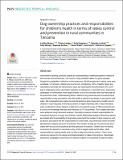| dc.description.abstract | Interventions tackling zoonoses require an understanding of healthcare patterns related to both human and animal hosts. The control of dog-mediated rabies is a good example. Despite the availability of effective control measures, 59,000 people die of rabies every year worldwide. In Tanzania, children are most at risk, contributing ~40% of deaths. Mass dog vaccination can break the transmission cycle, but reaching the recommended 70% coverage is challenging where vaccination depends on willingness to vaccinate dogs. Awareness campaigns in communities often target children, but do not consider other key individuals in the prevention chain. Understanding factors related to dog ownership and household-level responsibility for dog vaccination and child health is critical to the design of vaccination strategies. We investigated who makes household decisions about dogs and on health care for children in rural Tanzania. In the Kilosa district, in-depth interviews with 10 key informants were conducted to inform analysis of data from a household survey of 799 households and a survey on Knowledge Attitudes and Practices of 417 households. The in-depth interviews were analysed using framework analysis. Descriptive analysis showed responsibilities for household decisions on dogs' and children's health. Multivariate analysis determined factors associated with the probability of dogs being owned and the number of dogs owned, as well as factors associated with the responsibility for child health. Dog ownership varied considerably between villages and even households. The number of dogs per household was associated with the size of a household and the presence of livestock. Children are not directly involved in the decision to vaccinate a dog, which is largely made by the father, while responsibility for seeking health care if a child is bitten lies with the mother. These novel results are relevant for the design and implementation of rabies interventions. Specifically, awareness campaigns should focus on decision-makers in households to improve rabies prevention practices and on the understanding of processes critical to the control of zoonoses more broadly. | en_US |

